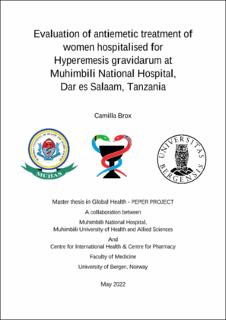| dc.description.abstract | Background: Significant global efforts are required to achieve the United Nations Sustainable Development Goal (SDG) 3; “Ensure healthy lives and promote well-being for all at all ages”. In a limited resource setting, such as Tanzania, maximizing the benefits achieved with available resources is essential for optimal health outcomes. Hyperemesis gravidarum (HG) is the most severe form of nausea and vomiting in pregnancy (NVP). A universally accepted definition of HG is lacking, but the condition entails intractable vomiting during pregnancy leading to complications including dehydration, weight loss, ketonuria, malnutrition, and/or electrolyte imbalance. Treatment options range from psychological care, emotional support, and dietary modifications to drug therapy (antiemetics, antacids), fluid management and total parental nutrition (TPN). Over the previous decade, management of HG have improved in large parts of the world, but most of the published treatment studies are from Europe and the United States. Very few studies are published from less-resources settings such as Asian and African countries. To the best of our knowledge, no published studies have assessed the hospital treatment and maternal demographics of HG patients in Tanzania. Furthermore, HG is the most common reason for hospitalization in early pregnancy and can result in maternal, fetal and/or child complications. Aim: The aim of the study is to describe the treatment provided for women hospitalised for Hyperemesis gravidarum at Muhimbili National Hospital, Dar es Salaam, Tanzania. Method: A retrospective cohort study of 163 women with HG admitted to Muhimbili National Hospital between 2004 and 2021. Results: Most women (98,8%) received some type of antiemetic treatment during the hospital stay or when discharged and 95,7% got some type of fluid treatment during the hospital stay. The number of hospital admissions throughout the pregnancy for women with HG at MNH ranges from minimum 1 to maximum 5. The most used antiemetic medications were ondansetron (n = 81, 49,7%), doxylamine-pyridoxin (n = 80, 49,0%), and metoclopramide (n = 75, 46,0%). In accordance with international guidelines combinations of antiemetics were commonly used at MNH. Almost half of the woman presented with electrolyte disturbances. No prominent difference in treatment of insured and uninsured individuals were found regarding antiemetics, fluid, vitamins nor antacids. | |
